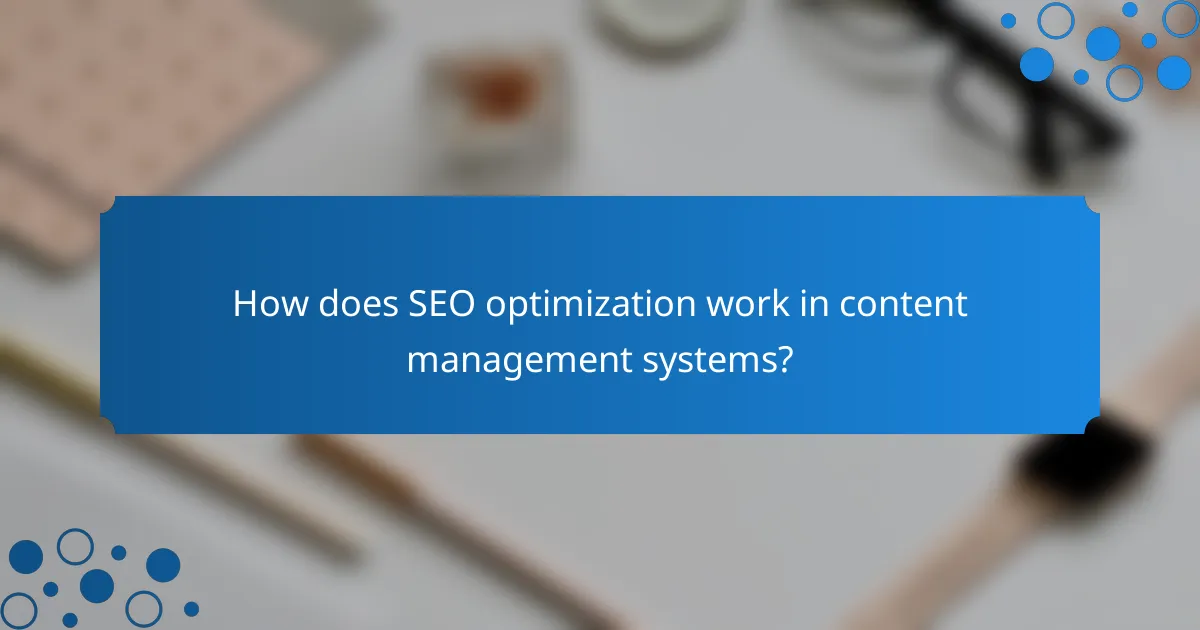Content Management Systems (CMS) play a crucial role in managing user permissions, multimedia support, and SEO optimization. By effectively configuring user permissions, organizations can enhance security and collaboration, while comprehensive multimedia capabilities enrich user engagement. Additionally, optimizing content for search engines ensures better visibility and reach, making the right CMS an essential tool for any digital strategy.

What are the best content management systems for user permissions in New Zealand?
The best content management systems (CMS) for user permissions in New Zealand include WordPress, Drupal, and Joomla. Each offers unique features that cater to different user roles and access controls, making it essential to choose one that aligns with your specific needs.
WordPress user role management
WordPress provides a straightforward user role management system that includes predefined roles such as Administrator, Editor, Author, Contributor, and Subscriber. Each role has specific capabilities, allowing for granular control over what users can do within the site.
For example, an Administrator can manage all aspects of the site, while a Subscriber can only read content. You can also create custom roles and capabilities using plugins, which is beneficial for tailoring user permissions to fit unique organizational needs.
Drupal permissions system
Drupal features a robust permissions system that allows administrators to define user roles and assign specific permissions to each role. This flexibility enables complex access control setups suitable for larger organizations or sites with diverse user needs.
For instance, you can create roles for different departments within a company, each with tailored permissions for content creation, editing, or publishing. This system is particularly advantageous for maintaining security and ensuring that users only access the content relevant to their roles.
Joomla access control levels
Joomla offers a comprehensive access control system that includes user groups and access levels. This allows you to manage who can view, edit, or publish content based on their assigned group, providing a structured approach to user permissions.
Joomla’s system supports multiple access levels, such as Public, Registered, and Special, which can be customized to fit specific requirements. This is useful for organizations that need to restrict content visibility based on user roles or membership status, ensuring that sensitive information remains secure.

How to set user permissions in a content management system?
Setting user permissions in a content management system (CMS) involves defining what actions users can perform within the platform. Properly configured permissions enhance security and streamline collaboration by ensuring that users have access only to the features they need.
Step-by-step in WordPress
In WordPress, user permissions are managed through roles such as Administrator, Editor, Author, Contributor, and Subscriber. Each role has predefined capabilities that dictate what users can do, from publishing posts to managing themes.
To set permissions, navigate to the “Users” section in the dashboard, select a user, and assign a role from the dropdown menu. For more granular control, consider using plugins like User Role Editor to customize capabilities further.
Configuring roles in Drupal
Drupal uses a flexible permissions system that allows for detailed role management. By default, it includes roles such as Anonymous User, Authenticated User, and Administrator, each with specific permissions.
To configure roles, go to the “People” section, click on “Permissions,” and assign capabilities to each role. You can create custom roles to tailor permissions based on your site’s needs, ensuring users have appropriate access levels.
Managing access in Joomla
Joomla features a built-in access control system that categorizes users into groups like Public, Registered, and Super User. Each group can be assigned different permissions for content, components, and modules.
To manage access, visit the “Users” menu, select “User Groups,” and adjust permissions for each group. This allows for a structured approach to user management, ensuring that sensitive areas of your site are protected while still allowing collaboration where needed.

What multimedia support features should a CMS have?
A robust content management system (CMS) should offer comprehensive multimedia support to enhance user engagement and content richness. Key features include efficient image handling, seamless video embedding, and reliable audio file support, all of which contribute to a more dynamic user experience.
Image handling capabilities
Effective image handling is crucial for any CMS, allowing users to upload, edit, and manage images easily. Look for features such as automatic image resizing, optimization for web performance, and support for various file formats like JPEG, PNG, and GIF.
Additionally, a good CMS should include tools for adding alt text and captions to images, which not only improves accessibility but also enhances SEO. Consider platforms that offer bulk upload options and integration with image libraries for streamlined workflows.
Video embedding options
A CMS should facilitate easy video embedding from popular platforms like YouTube and Vimeo, allowing users to enrich their content without heavy bandwidth costs. Look for features that support responsive video players, ensuring videos display correctly on all devices.
Consider whether the CMS allows for custom video settings, such as autoplay, loop, and thumbnail selection. This flexibility can significantly enhance user engagement and provide a tailored viewing experience.
Audio file support
Audio file support is essential for podcasts, music, and other audio content. A CMS should allow users to upload various audio formats, including MP3 and WAV, and provide options for embedding audio players directly into posts.
Ensure the CMS offers features like customizable audio players and support for playlists, which can enhance the listening experience. Additionally, check for compatibility with popular audio hosting services to simplify content management.

How does SEO optimization work in content management systems?
SEO optimization in content management systems (CMS) involves enhancing website visibility on search engines through various tools and features. This process includes optimizing content, improving site structure, and utilizing plugins or built-in functionalities to boost search rankings.
SEO plugins for WordPress
WordPress offers a variety of SEO plugins that simplify the optimization process. Popular options like Yoast SEO and All in One SEO Pack provide features such as keyword analysis, readability scores, and XML sitemap generation. These tools help users easily implement best practices without needing extensive technical knowledge.
When using these plugins, focus on key areas like meta descriptions, title tags, and alt text for images. Regularly updating content and monitoring performance through analytics can further enhance your site’s SEO effectiveness.
Built-in SEO features in Drupal
Drupal includes several built-in SEO features that cater to advanced users. It supports customizable URL structures, meta tags, and clean HTML output, which are essential for search engine indexing. Additionally, modules like Pathauto and Metatag can be integrated to automate and enhance these functionalities.
To maximize SEO in Drupal, ensure that your site’s content is structured logically and that you utilize taxonomy effectively. Regularly audit your site for broken links and ensure that all images have descriptive alt text to improve accessibility and SEO.
Joomla SEO settings
Joomla provides a range of SEO settings that can be configured to improve search engine visibility. Users can enable search engine-friendly URLs, create meta descriptions, and utilize the built-in redirect manager to handle broken links effectively. These settings are accessible through the global configuration options.
For optimal results, regularly update your content and utilize Joomla’s built-in analytics to track performance. Avoid duplicate content by using canonical tags, and ensure that your site is mobile-friendly, as this is a significant factor in search rankings today.

What are the key criteria for selecting a CMS in New Zealand?
When selecting a content management system (CMS) in New Zealand, focus on user permissions flexibility, multimedia support capabilities, and SEO optimization features. These criteria ensure that the CMS meets your specific needs for managing content effectively and reaching your target audience.
User permissions flexibility
User permissions flexibility is crucial for managing access to content within a CMS. It allows you to define who can create, edit, or publish content, which is especially important for larger teams or organizations. Look for systems that offer granular control over roles and permissions, enabling you to customize access based on user responsibilities.
Consider whether the CMS allows for multiple user roles, such as administrators, editors, and contributors. This hierarchy helps maintain content integrity and security. Additionally, ensure that the system can easily adapt to changes in your team structure or project requirements.
Multimedia support capabilities
Multimedia support capabilities are essential for creating engaging content. A good CMS should allow you to easily upload, manage, and display various media types, including images, videos, and audio files. Check if the system supports popular file formats and offers features like image optimization and video embedding.
Evaluate how the CMS handles multimedia content in terms of storage and performance. Some systems may have limitations on file sizes or types, which can hinder your content strategy. Look for platforms that integrate well with third-party media services or provide built-in tools for multimedia management.
SEO optimization features
SEO optimization features are vital for improving your website’s visibility in search engines. A CMS should provide tools for optimizing content, such as customizable meta tags, URL structures, and sitemaps. These features help enhance your site’s search engine ranking and attract more visitors.
Additionally, consider whether the CMS offers built-in analytics to track SEO performance and user engagement. Some platforms may also provide guidance on best practices for content creation and keyword usage, which can be beneficial for enhancing your overall SEO strategy in the competitive New Zealand market.

How do CMS integrations enhance functionality?
CMS integrations significantly enhance functionality by allowing seamless connections between content management systems and various external tools. This integration enables users to streamline processes, improve content distribution, and gain valuable insights through enhanced data analysis.
Integrating with marketing tools
Integrating a CMS with marketing tools can optimize campaigns and improve audience targeting. For example, connecting to email marketing platforms like Mailchimp or social media tools like Hootsuite allows for automated content sharing and audience engagement tracking.
When choosing marketing tools, consider compatibility and ease of use. Look for integrations that allow for real-time updates and analytics to measure campaign effectiveness. Avoid tools that require extensive manual input, as this can lead to errors and inefficiencies.
Connecting to analytics platforms
Connecting your CMS to analytics platforms like Google Analytics provides insights into user behavior and content performance. This integration allows you to track metrics such as page views, bounce rates, and conversion rates, helping you make data-driven decisions.
To effectively utilize analytics, set up specific goals and track key performance indicators (KPIs) relevant to your content strategy. Regularly review this data to identify trends and areas for improvement, ensuring your content remains relevant and engaging.
Third-party plugin compatibility
Third-party plugin compatibility is crucial for extending the functionality of your CMS. Plugins can add features such as SEO optimization, multimedia support, and enhanced security, allowing for a more robust content management experience.
When selecting plugins, prioritize those that are regularly updated and well-reviewed. Be cautious of using too many plugins, as this can slow down your site and create security vulnerabilities. Regularly audit your plugins to ensure they are still necessary and functioning correctly.
